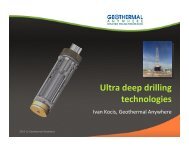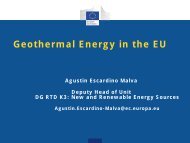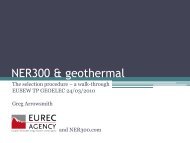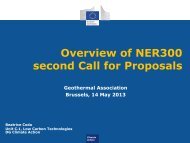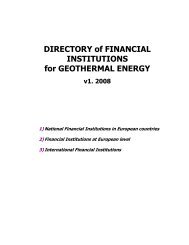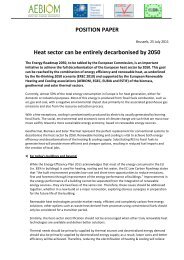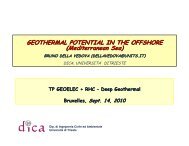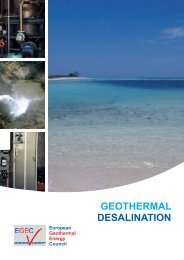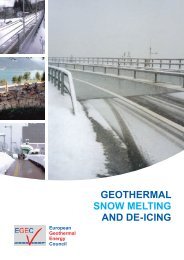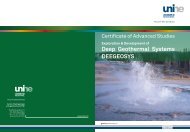Strategic Research and Innovation Agenda for Renewable ... - EGEC
Strategic Research and Innovation Agenda for Renewable ... - EGEC
Strategic Research and Innovation Agenda for Renewable ... - EGEC
Create successful ePaper yourself
Turn your PDF publications into a flip-book with our unique Google optimized e-Paper software.
6<strong>Strategic</strong> <strong>Research</strong> <strong>and</strong> <strong>Innovation</strong> <strong>Agenda</strong> <strong>for</strong> <strong>Renewable</strong> Heating & CoolingDistrict Heating <strong>and</strong> Cooling6.3.2 <strong>Research</strong> <strong>and</strong> innovation priorities with impact in the Medium <strong>and</strong> Long TermGEO.13ObjectiveEnhanced Geothermal Systems (EGS)EGS technology can provide a major increase in the geothermal resource base, as EGScould be used <strong>for</strong> a wide variety of applications. Today, only a h<strong>and</strong>ful of research facilities<strong>and</strong> two operational power plants exist.The key challenges <strong>for</strong> this application are explored in detail in the sectorial documenton strategic research priorities <strong>for</strong> geothermal technology 69 . The main priorities are:• Hard rock drilling technology <strong>and</strong> well completion• Fracture identification, reservoir stimulation, seismicity• Logging/testing/monitoring, reservoir modelling• Sustainability, rock/water interactionsEGS can be considered the major technology <strong>for</strong> future market increase of deep geothermalenergy use.State of the art The basic technology <strong>for</strong> fracking in geothermal sites was already developed in the 1980s.The first EGS (power-only) plant was inaugurated in 2007, with a second one being open thefollowing year. Other projects are under development.TargetsType of activityMake EGS a cost-competitive technology applicable nearly everywhere in Europe.20% <strong>Research</strong> / 50% Development / 30% DemonstrationGEO.14ObjectiveResource Assessment <strong>for</strong> deep geothermal heat useThe primary objective is to improve the quality of feasibility studies, to achieve bettersystem design <strong>and</strong> adaptation to the geological conditions on site. Knowledge of the geothermalunderground reservoir needs to be improved. This is in particular a topic of European interest<strong>and</strong> with added value of international cooperation, as these reservoirs do not follow nationalborders. Some trans-national projects supported by the EU have already proven this conceptin certain regions. The final target should be the creation of a European geothermal data baseof reservoirs suitable <strong>for</strong> deep geothermal applications in combination with DHC networks.Exploration technologies <strong>for</strong> subsurface imaging need to be improved, as well as modellingtools <strong>for</strong> resource assessment <strong>and</strong> reservoir per<strong>for</strong>mance evaluation.An inherent problem of all deep geothermal projects is the geological risk, i.e. the uncertainty ofwhat actually will be found at depth in the reservoir. Here further R&D is required to improve riskassessment, to reduce the exploration risk by better investigations <strong>and</strong> to develop new solutions<strong>for</strong> mitigating the exploration risk.State of the artTargetsType of activityPresent technology is mainly based on equipment <strong>and</strong> software developed <strong>for</strong> thehydrocarbon industry (i.e. geophysical software, logging tools...) <strong>and</strong> converted <strong>for</strong> usein the geothermal sector.In future, not a single project should be ab<strong>and</strong>oned after the decision to go ahead with drilling.50% <strong>Research</strong> / 50% Development<strong>Research</strong> <strong>and</strong> <strong>Innovation</strong> Priorities Predominant type of activity ImpactGEO.10 Deep Drilling Development By 2020GEO.11 Production technologies Demonstration By 2020GEO.12 Surface systems <strong>for</strong> heat uses in DHC (incl.CHP) Demonstration By 2020GEO.13 Enhanced Geothermal Systems (EGS) Development By 2030GEO.14 Resource Assessment <strong>for</strong> deep geothermal heat use <strong>Research</strong> / Development By 2030Table 17: research <strong>and</strong> innovation priorities <strong>for</strong> geothermal DHC6.4 <strong>Research</strong> <strong>and</strong> innovation priorities<strong>for</strong> DHC technologiesThe underst<strong>and</strong>ing of different energy dem<strong>and</strong> profiles <strong>for</strong> various customer groups, e.g.industry, agriculture, residential <strong>and</strong> service sectors, as well as their interaction is key tosupport the future expansion of DHC systems using renewable sources. The DHC sector willexperience situations where both old <strong>and</strong> new generations of technologies must be combined:flexibility will be a key feature of future thermal energy networks. Modern DHC systemscan still benefit from technological advancements in the generation, distribution <strong>and</strong>customer sides, allowing the implementation of a holistic approach to thermal energydem<strong>and</strong> (Figure 43).69RHC-Plat<strong>for</strong>m (2012b).Cfr. Chapter 4.6.68



